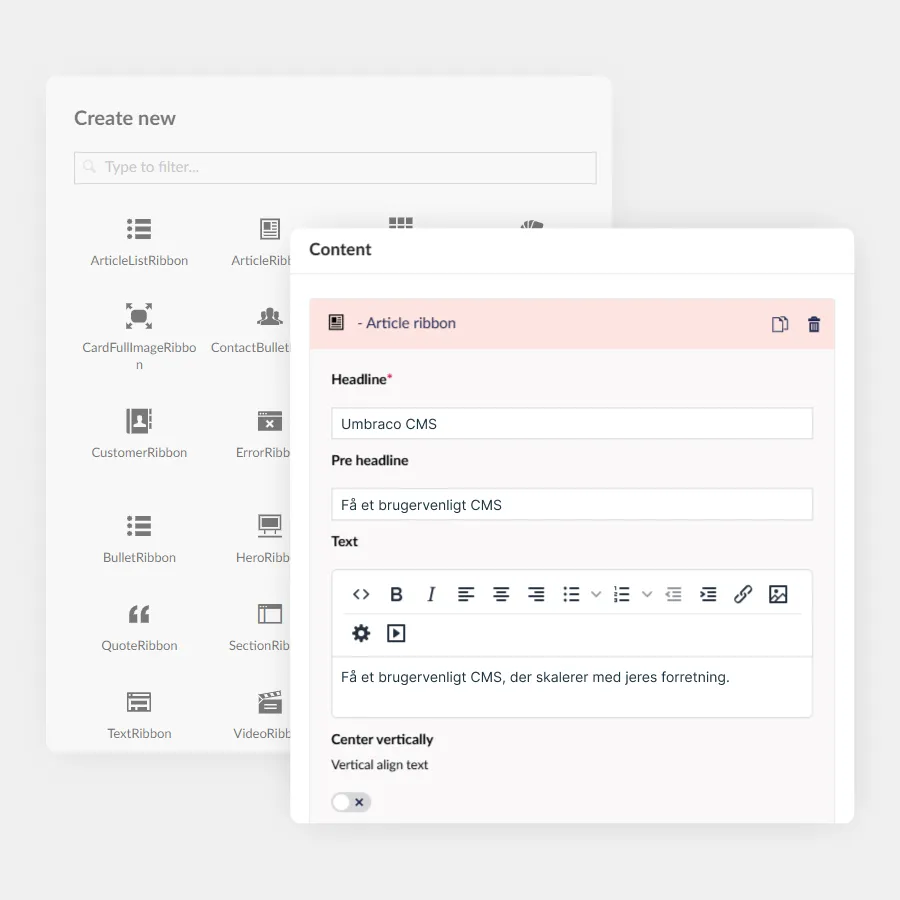

Umbraco gives you a robust digital foundation for your next digital project
Umbraco is a mature open-source CMS built on .NET technology, providing a solid starting point for your next digital solution, whether it’s a brand website, a customer portal, or a B2B webshop with 14 language layers.
Whatever your needs are, Umbraco can be customized to support your digital strategy and ambitions.
With strong integration support, a user-friendly interface, and a large, active developer community, Umbraco is an obvious choice for anyone looking for a scalable CMS as the foundation for their next digital project.

Get a user-friendly CMS that supports your content management
An IT system will never become an asset for your company if no one can or wants to use it. That’s why usability is a key parameter for CMS systems, as this is typically where data from various sources is gathered for the final user experience.
With Umbraco’s intuitive back end, it’s easy for both technical and non-technical employees to update and manage your content - without having to dive into complicated code or spend a lot of time on training.
We typically build the user-friendly interface around customized content modules tailored to your content and needs. With Umbraco’s module engine, we can create flexible layouts that ensure a consistent and lightning-fast user experience for all your visitors.
With Umbraco, your marketing teams can quickly respond to market needs and launch campaigns in near real-time, reducing your time-to-market. Paired with an efficient integration to a PIM system, you have a strong foundation for capturing customers’ attention.
Umbraco scales with your business
Umbraco supports all the needs we typically see in complex B2B companies. This could include support for multiple languages, the need to launch content/products across multiple channels, and a solid role-permission scheme for access control.
With its robust APIs and support for a headless architecture, it’s easy to get Umbraco to exchange data with external sources such as ERP and CRM. This allows Umbraco to become a central component in ensuring a great user/customer experience when data from various systems is combined and used to deliver a personalized experience.
The proven .NET engine and the large open source community around Umbraco provide a vendor like us with the best foundation to find the right solutions in collaboration with you. The risk of getting stuck or being unable to support your needs is therefore greatly reduced with Umbraco.
Increase your efficiency with strong integrations
"Umbraco is built to be extendable" – this is how Umbraco describes itself on their marketplace, which offers a wide range of standard integrations for various integration modules built by Umbraco’s partners.
Most companies today need to exchange data between their different IT systems. Umbraco, as a CMS, is typically the place where data from various sources meets and is combined into the final user experience. Therefore, integrations with ERP, PIM, CRM, and DAM systems are usually part of the scope when most companies build new websites and webshops.
Umbraco’s integration engine uses a number of popular standard protocols for data exchange, making the development of integrations easier and protecting you from vendor lock-in.
Build strong integrations for your Umbraco
Support multiple languages, channels, and markets with a headless Umbraco
Umbraco is built with native support for multiple languages, making it easy to manage and present your products and services to different markets.
With Umbraco’s CMS, you can create separate language versions of your website and configure localized content structures that match regional requirements and cultural nuances in the markets you operate in.
If you choose a headless Umbraco, you can separate the content in your Umbraco from the presentation layer (typically your website or webshop). This means that content managed centrally in Umbraco can be distributed via APIs to various platforms - such as websites, mobile apps, IoT devices, or similar.
In other words, your company is well equipped for the scaling ambitions you have if you choose Umbraco.
Flexibility and scalability with Umbraco baselines
With Umbraco Baselines, you get the ability to reuse central modules and features across multiple sites - while only having to maintain your components in one place!
Flexibility, security, and scalability are three of the most important parameters we evaluate a CMS on. With Umbraco Baselines, flexibility and scalability are especially in focus, as you can quickly build on an existing base in a new setup - for example, a new brand site.
Umbraco FAQ
Everything you should know about the popular CMS
What is Umbraco?
Umbraco is an Open Source CMS (Content Management System) developed on .NET technology (ASP.NET Core).
With Umbraco, you get a user-friendly, integration-friendly, and mature system to build the final customer experience out of your data and content.
Why choose Umbraco CMS?
Umbraco is a mature, open-source system that supports a range of popular architecture choices, all contributing to enabling your business to optimize operations or scale and enter new markets to meet your growth ambitions.
Being open-source means that as an Umbraco partner, we have great opportunities to customize every part of Umbraco to meet the demands our customers have.
Umbraco is a mature CMS that has proven it can support even the most complex business logics, the largest product databases, and the most demanding frontend requirements. A well-developed Umbraco solution will also always emphasize a user-friendly interface, so editors working with content production or campaign planning can work uninterrupted and efficiently.
Umbraco is also a popular CMS supported by many providers. By choosing an Umbraco solution, you avoid being tied to a single supplier, as both the .NET core and the technologies - such as the API engine in Umbraco - are built around standard protocols supported by numerous development houses.
Is Umbraco secure?
Umbraco is built on a solid security architecture with regular updates, support for HTTPS, and advanced user access controls.
Umbraco can also integrate with external security solutions (e.g., 2FA) and community-developed plugins that help protect against external threats and secure your and your customers’ data.
At PicoPublish, we assist you with setting up the necessary security measures and gladly train your staff in the secure use of the systems and solutions we implement together.
Does Umbraco support content in multiple languages?
Yes. Umbraco is built so that modules and the structure of the CMS can be reused across the language layers set up in the solution.
If you have ambitions to sell your products in multiple markets or support several different languages on your website or webshop, Umbraco can support the workflows connected to language versioning of your texts.
On Umbraco’s own Marketplace, you can also find several plugins developed by Umbraco partners that provide access to DeepL, Google Translate, and other translation features.
How does Umbraco support SEO?
Umbraco offers several options for working with SEO, including customization of URL structures, title/meta tags, and schema markup.
In the control panel, it is easy to implement SEO best practices so you can secure higher rankings in search engines and thereby attract the right users and customers to your site.
For media/images, it is also possible to optimize through descriptions, meta/alt texts, cropping, and compression, ensuring both accessibility and performance - both important ranking factors.
Does Umbraco support an omni-channel strategy?
Yes. Especially a headless Umbraco solution is well-positioned to support an omni-channel strategy.
If your content needs to be shared across multiple channels and platforms, Umbraco can be part of a setup where parts of the content come from your Umbraco CMS. Depending on whether you have a DAM system, or data in ERP or PIM that also needs to be merged into the final user experience, you can build integrations to and from Umbraco that ensure the right data flow.
Can I reuse my Umbraco modules across sites?
Yes.
By building standard modules (e.g., contact forms, product overviews, or news feeds), we only need to develop each module once, after which you can reuse modules across many different sites.
This means that if there is a need to update or adjust a module, the change only has to be made in one place. This saves both time and costs for maintenance and makes it possible for larger corporations to have multiple websites following a consistent brand identity, without all sites and modules needing to be redesigned and redeveloped.
Which ERP systems does Umbraco support?
Basically, we believe that Umbraco can support all ERP systems, as Umbraco’s APIs are flexible enough to onboard almost any data format and type we can think of.
Modern ERP systems like Microsoft Dynamics 365 Finance & Operations, NAV, and SAP typically also offer API-based data exchange, making it easier to transfer data from ERP to Umbraco.
Older or less mature ERP systems may require more extensive integrations, where the integration also handles data manipulation to make the format and file type fit the protocols Umbraco uses.
Regardless of which ERP solution you have, or which PIM/CRM/DAM systems you use, there may be efficiency and scalability benefits to be gained by building the right integrations that support your processes.
What is Umbraco Cloud?
Umbraco Cloud is Umbraco’s managed hosting solution, described by Umbraco itself as an “all-in-one” package.
With Umbraco Cloud, Umbraco handles all the details around your hosting. Typically, cloud-hosted solutions are slightly more expensive but come with the advantage that you avoid having to maintain and update your solution to the same extent as if you or your web provider hosted it for you.
An Umbraco Cloud solution also provides access to CDN, role/permission management, and cloning of content between different Umbraco Cloud environments.
Can Umbraco integrate with my ERP/PIM system?
Yes.
Umbraco uses modern APIs that ensure your Umbraco partner can easily develop and customize integrations that either send data to Umbraco or receive data from Umbraco.
Most companies today have many different types of data stored in various systems. The secret to a good customer journey is presenting the customer with the right data, in the right quality, at the right time.
Typically, the ERP system holds master data about the product created when the product is introduced. This typically includes data like name, product number/item number, EAN number, weight, dimensions, etc.
The ERP system often also holds knowledge about product relations - what products are variants? Which products are “parents”? Which categories do the products belong to?
ERP data is often sent to the PIM system where products are finalized and prepared for sale.
The data found in ERP/PIM is often necessary to offer the customer a good buying experience. Therefore, most companies choose to make integrations between their ERP/PIM and their CMS (e.g., Umbraco), where the final buying experience is typically arranged.
Is Umbraco better than other CMS?
There is never a black-and-white answer to the question of which technology is “best.”
Umbraco has clear strengths in its openness, the large community, and the user-friendly interface, making it ideal for the types of projects we do at PicoPublish.
Umbraco excels particularly in being easy to build on (.NET framework is widely used and supports modern architecture choices). This means we can build custom functions into your solution, leverage solutions and inspiration from a large community, and almost always support your business needs.
Other systems may come with a number of standard components that allow faster start-up in creating products, content/pages, etc. - but this comes at the cost of not necessarily being able to customize those functions, which would live in a “locked” system.
There will always be pros and cons regardless of which CMS you choose. Therefore, always ask a partner or advisor for guidance before deciding which technology to select.






